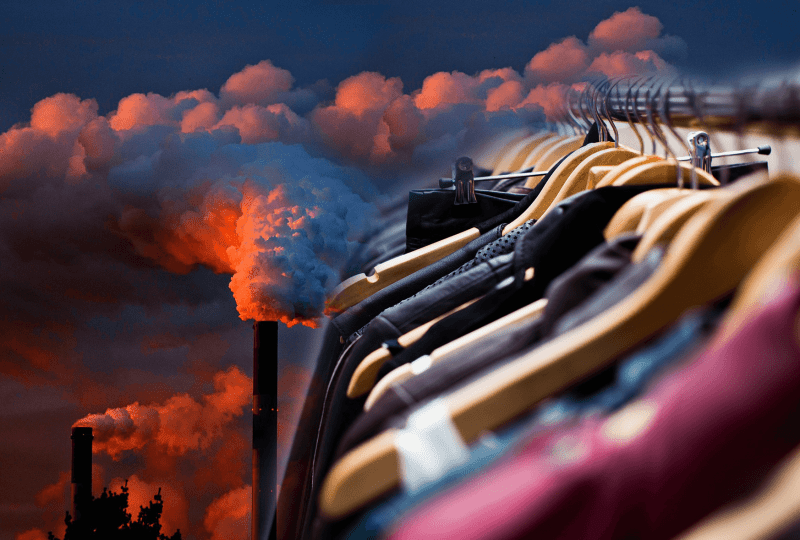Behind every T-shirt, every pair of jeans, and every sock lies a harsh reality: the textile industry is one of the most polluting on the planet. Clothes may look harmless, but their production has a heavy environmental cost. From conventional cotton farming to chemical dyeing and thousands of kilometers of shipping, textile pollution is a major—yet underestimated—issue. Here’s why… and how we can act.
Textile industry: oversized pollution we don’t talk about enough
The textile industry is now one of the biggest polluters in the world. It may not be as visible as factory smoke or car exhaust, but its environmental impact is no less toxic.
Textile pollution, by the numbers
Let’s look at a few key figures:
-
1.2 billion tons of CO₂ are emitted by the textile industry every year—more than all international flights and maritime shipping combined,
-
93 billion m³ of water are consumed annually,
-
20% of global water pollution is linked to textile dyeing and treatment.
Textile pollution is not a detail. It’s a massive issue, buried deep behind our piles of T-shirts.
From cotton fields to your wardrobe: a high-impact journey
That cheap pair of socks you picked up on sale? It’s been through a climate nightmare.
-
Conventional cotton is grown using heavy pesticides and excessive irrigation,
-
Dyes are loaded with chemicals that rarely get recycled,
-
Most garments are made thousands of kilometers away, often in coal-powered factories,
-
And clothes are worn just 7 times on average before being tossed.
In short, the textile industry is a toxic mix: greenhouse gases, water and oil consumption, and mountains of waste.
The well-ironed illusion of carbon neutrality
Some brands have found a trick: plant three trees or buy a “carbon credit” for every ton of CO₂ emitted. Then they call themselves “climate neutral.” Magic? More like greenwashing. It's like buying your way out of guilt. Burn now, maybe offset later.
At BLUEBUCK, we’re not fans of these sleights of hand. We don’t claim to be climate neutral. Why? Because it would be dishonest. Instead, we’re committed to actually reducing our emissions—starting now, not in ten years.
So, what are the real solutions?
Reducing textile pollution means activating three key levers:
-
Cutting unnecessary production,
-
Extending the lifespan of clothing,
-
Eliminating the worst practices (virgin synthetics, toxic dyes, global freight).
Will BLUEBUCK save the planet with its organic boxers? No. But can we be less harmful? Absolutely. At BLUEBUCK, we’re committed to:
-
Reducing our emissions by 50% within 3 years,
-
Conducting lifecycle assessments of our products,
-
Continuously innovating in materials and processes,
-
Donating 1% of our revenue to environmental causes.
No miracle solution. Just real actions against textile pollution.
We’re not saving the planet. But we’re doing something.
BLUEBUCK made a bold bet: creating underwear, T-shirts, and socks without adding to the environmental mess. Let’s be real—zero impact doesn’t exist (unless you live naked in a cave, and even then…). But we can do better.
This is how we’re tackling textile pollution—on our scale.
Our production is local and clean
At BLUEBUCK, we’re committed to controlling every step of our production to reduce our environmental footprint. That’s why all our underwear is 100% made in Europe—mostly in Portugal.
This local approach means significantly shorter transportation distances, lower emissions, and stronger support for regional economies. Our suppliers are all within 30 km of one another, making our supply chain more efficient and responsible.
Even our warehouse is in Portugal, ensuring our products travel the bare minimum before reaching your drawer.
We rely on responsible energy
Energy use is another key part of our environmental strategy. All our factories run on green electricity from renewable sources like solar and hydro power.
In Austria, for example, our fiber supplier runs on 80% hydropower—a clean, renewable source. It drastically lowers our carbon footprint, already far below that of most textile factories around the world.
We use sustainable raw materials
Choosing the right materials is just as essential. We prioritize low-impact textiles:
-
GOTS-certified organic cotton, grown without pesticides or synthetic fertilizers,
-
Tencel™, a wood-pulp fiber from sustainably managed forests,
-
Recycled fibers, made from plastic waste collected from oceans.
All our fibers are traceable, durable, and sourced from Europe—ensuring ethical and eco-conscious production standards.
We design collections built to last
We believe durability goes beyond materials. That’s why our collections are made to endure—far from fast fashion trends. In ten years, we’ve launched only three underwear collections with timeless cuts that never go out of style.
We don’t do seasonal sales or overstocked capsule collections. Every roll of fabric in our workshops is used 100%—no waste, no excess. We focus on products that last, not on passing trends.
~~~
We won’t guilt-trip you for wearing a T-shirt made in Asia or buying socks on sale. But next time you shop, ask yourself: is what I wear contributing to a massive industry of waste, or helping shift things in the right direction?
Choosing BLUEBUCK isn’t about virtue signaling. It’s about not pretending you don’t know. It’s about choosing clothes that last over clothes that lie. It’s believing textile pollution doesn’t have to be inevitable.
And honestly, that organic cotton boxer will feel a lot better than a guilty conscience.
